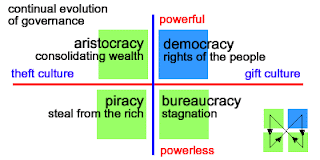 Sherlock Holmes solved a mystery by noticing "the dog that did not bark in the night". It's much easier to notice a dog that did bark than a dog that did not. Knowing what's missing requires a sense of the big picture. Teaching twelve different college courses gave me an opportunity to discern a big picture of patterns in the student enrollment. I began seeing what was missing in most of the students enrolled in Employee Training & Development or Human Resource Management. I saw how this differed from students enrolled in Small Business Management or Organizational Behavior. Clark Aldrich brought all this back to mind yesterday in his post on the Learning Circuits Blog:
Sherlock Holmes solved a mystery by noticing "the dog that did not bark in the night". It's much easier to notice a dog that did bark than a dog that did not. Knowing what's missing requires a sense of the big picture. Teaching twelve different college courses gave me an opportunity to discern a big picture of patterns in the student enrollment. I began seeing what was missing in most of the students enrolled in Employee Training & Development or Human Resource Management. I saw how this differed from students enrolled in Small Business Management or Organizational Behavior. Clark Aldrich brought all this back to mind yesterday in his post on the Learning Circuits Blog:I experienced the reverse problem. When I spoke of results, metrics, outcome measures, impact or value, I lost my HR students. I was not speaking their language. It appeared most students drawn to the HR and T&D professions are process oriented. From a results orientation, they appear to be "going through the motions", "spinning their wheels", or "stuck in a rut". From their own process "epistemic frame", they are complying with management directives, conforming to policy requirements and implementing "change management plans".2. Your clients, be they sales teams or management, live in a world of results. That is the language they speak, and you are too removed from them if you are not speaking this language.
When I talked of metrics with students in management courses, I spoke their language. They are preparing to "live in a world of results" as Clark says. Yet I eventually saw what was missing in their results orientation also. The focus on results can escalate adversarial contexts, reward shortcuts, disrupt ecologies and harm informal communities. Their results orientation needed to be combined with a system orientation that considers side effects, context and widespread repercussions. (Geetha's comment on Clark's post adds some context that was missing)
As I further explored storytelling, game design and uses of the theater metaphor in business, something else appeared missing from all the process, results and systems orientations.Everything we do is creating an experience for ourselves and others. We are always telling a story with our words and actions. We relentlessly create a game with our "epistemic frame" that sets up others to score points or get penalized. We continually succeed or fail at being immersive or engaging. We are either perpetuating "more of the same old same old" or transforming our world.












